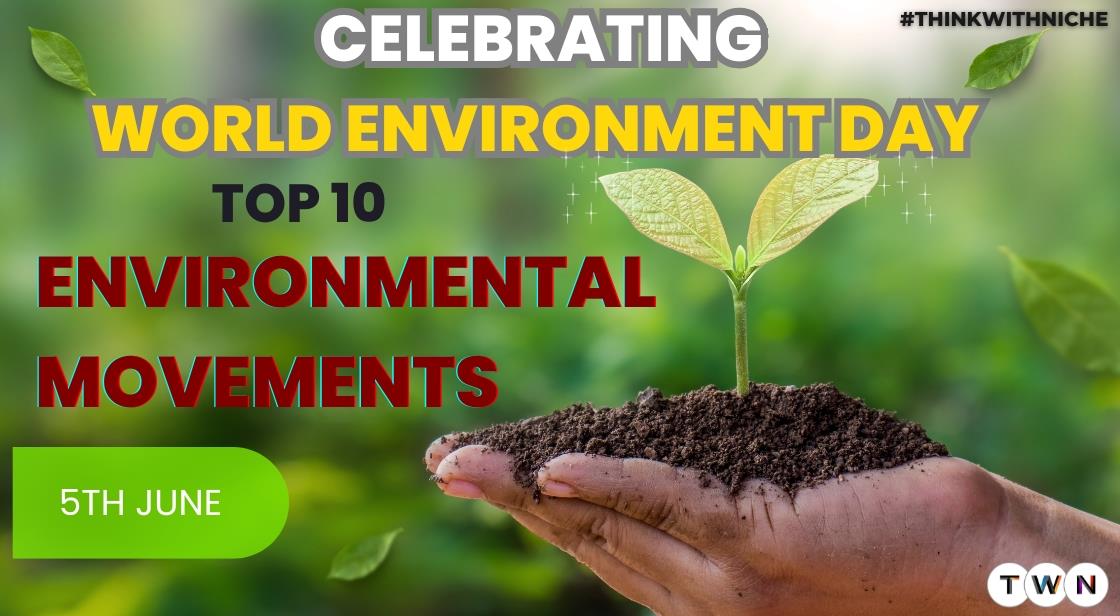Celebrating World Environment Day 2025 with the Top 10 Environmental Movements

Blog Post
Every year, on June 5, the world comes together to celebrate World Environment Day—a powerful occasion dedicated to raising awareness about the urgent need to protect our planet. As environmental challenges intensify, this global event serves as both a reminder and a call to action for individuals, communities, and governments alike.
The 2025 theme, “Ending Global Plastic Pollution,” highlights one of the most pressing threats facing Earth today, emphasizing the importance of collective responsibility and sustainable change.
Beyond this annual observance, the fight to safeguard the environment has been fueled by numerous influential movements around the world. These grassroots campaigns, youth-led strikes, global policy agreements, and innovative social enterprises have galvanized millions to take action, driving meaningful progress toward a healthier planet.
From the tree-hugging Chipko Movement in India to the youth-powered Fridays for Future climate strikes, and from large-scale international treaties like the Paris Agreement to pioneering initiatives combating plastic pollution, these movements demonstrate the power of people united for environmental justice.
In this blog, we explore the significance of World Environment Day 2025 and delve into ten of the most impactful environmental movements that continue to inspire change across the globe. Together, they form a roadmap for how we can collectively protect nature, reduce pollution, and build a sustainable future for generations to come.
World Environment Day 2025 Highlights Global Call for Land Restoration
Every year on June 5, people across more than 150 countries unite to observe World Environment Day, a global movement dedicated to protecting the planet. It serves as a powerful reminder of our shared duty to care for the Earth, inspiring meaningful action from individuals, communities, governments, and organizations alike.
Why World Environment Day Is More Important Than Ever
World Environment Day is not just symbolic — it drives real change. From urban clean-up drives to tree-planting events and campaigns against single-use plastics, people everywhere become agents of change. The day acts as a global wake-up call, reminding us that small steps can lead to massive environmental impact.
The 2025 Theme: Ending Global Plastic Pollution
Each year, World Environment Day emphasizes a critical environmental issue. For 2025, the focus is on eliminating global plastic waste, aligning with the UNEP’s #BeatPlasticPollution campaign. The initiative urges individuals, industries, and governments to minimize plastic usage and switch to sustainable alternatives.
A Day of Action Across the Globe
From schools and workplaces to local governments and grassroots organizations, millions participate in awareness campaigns and environmental initiatives. This year’s events center around one of the most pressing issues facing our planet: plastic pollution. With the 2025 theme “Ending Global Plastic Pollution,” the day encourages people everywhere to adopt more sustainable habits.
The History and Legacy of World Environment Day
Established in 1974, World Environment Day has evolved into the largest international platform for environmental advocacy. It highlights the importance of safeguarding nature, preserving biodiversity, and promoting sustainable lifestyles, ensuring a habitable planet for generations to come.
Also Read: 2024 Renewable Energy Predictions: How Technology, Policy, and Investment Will Shape the Future
South Korea Takes the Lead as 2025 Host Nation
South Korea is hosting the global celebrations for World Environment Day 2025. The spotlight will shine on Jeju Province, known for its eco-conscious policies. With an ambitious goal to eliminate plastic waste by 2040, Jeju is a model of sustainability through initiatives like eco-tourism, waste segregation, and recycling innovation.
Events and Initiatives to Watch
As the host, South Korea will spearhead global discussions, launch policy initiatives, and organize engaging activities. These include:
-
Plastic cleanup campaigns
-
Educational panels and forums
-
Public commitments to reduce plastic use
-
Exhibitions showcasing innovative green technologies
Their leadership aims to inspire other countries to follow suit.
How Individuals Can Contribute
The fight against plastic pollution starts with each of us. Simple lifestyle changes—like refusing single-use plastics, using reusable water bottles, or choosing sustainable travel options—can significantly reduce waste. Travelers, in particular, play a critical role in preserving the natural charm of destinations by making eco-friendly choices.
Building a Greener Future Together
World Environment Day 2025 sends a strong message: ending plastic pollution requires both global cooperation and local initiative. By taking mindful actions today, we help create a cleaner, healthier planet for tomorrow.
Top 10 Most Influential Environmental Movements for World Environment Day 2025
Protecting the planet has become one of the most pressing challenges of the 21st century. Over the decades, several environmental movements have emerged to raise awareness, demand change, and hold governments and corporations accountable for environmental damage. These movements have varied in origin, strategy, and reach, but all share one goal: safeguarding the environment for future generations. Below are ten of the world’s most influential environmental movements that have made a tangible impact globally.
1. Fridays for Future (FFF)
Founded by: Greta Thunberg (Sweden, 2018)
Fridays for Future is a youth-led global climate movement initiated by Swedish teen activist Greta Thunberg. It began in August 2018 when Greta sat outside the Swedish Parliament with a sign that read "Skolstrejk för klimatet" (School Strike for Climate). Her solo protest inspired millions of students across the globe to skip school on Fridays to demand climate action from their governments.
Over time, FFF became a powerful voice in the global climate dialogue. The movement has organized multiple international climate strikes, with participation from over 150 countries. It emphasizes the urgency of climate change, drawing attention to scientific consensus and pressing world leaders to align policies with the Paris Agreement goals. Its impact is evident in heightened youth engagement and increased political focus on climate-related issues.
2. The Chipko Movement (India, 1973)
Slogan: “Ecology is permanent economy”
One of the earliest examples of non-violent environmental activism, the Chipko Movement emerged in the Indian state of Uttarakhand (then part of Uttar Pradesh) in the 1970s. Villagers, especially women, physically hugged trees to prevent commercial loggers from cutting them down. "Chipko" translates to "hug" or "embrace," symbolizing their commitment to protect forests.
Led by environmentalists like Sunderlal Bahuguna and Gaura Devi, the movement resulted in the Indian government implementing forest conservation reforms. More importantly, it inspired future grassroots campaigns and highlighted the interconnection between ecology, livelihoods, and social justice.
3. Extinction Rebellion (United Kingdom, 2018)
Focus: Climate emergency and biodiversity loss
Extinction Rebellion (XR) is an international movement using non-violent civil disobedience to compel government action on climate breakdown, biodiversity loss, and the risk of social and ecological collapse. Launched in the UK in 2018, XR quickly gained attention for its bold and disruptive protests—blocking roads, staging die-ins, and even gluing themselves to buildings.
The movement's demands include governments declaring a climate emergency, reducing carbon emissions to net-zero by 2025, and creating citizens' assemblies to oversee environmental policies. XR has grown into a global network with chapters in dozens of countries, bringing fresh urgency to the climate crisis and influencing media coverage and political discourse.
4. Green Belt Movement (Kenya, 1977)
Founded by: Wangari Maathai
The Green Belt Movement was launched by Nobel Peace Prize laureate Wangari Maathai to combat deforestation and environmental degradation in Kenya. What began as a tree-planting campaign led by women turned into a broader movement advocating for women's rights, sustainable development, and democratic governance.
Over the years, the Green Belt Movement has helped plant over 50 million trees across Kenya. The initiative empowered rural women through environmental stewardship, contributing to poverty reduction and improved ecological health. Its influence extended far beyond Kenya, inspiring reforestation projects and women-led conservation initiatives worldwide.
5. Earth Day Movement (Global, 1970)
Observed on: April 22
The first Earth Day was celebrated in 1970 in the United States and marked the beginning of the modern environmental movement. Organized by Senator Gaylord Nelson and activist Denis Hayes, it mobilized 20 million Americans to rally for environmental reform. Earth Day led to the creation of the U.S. Environmental Protection Agency and the passage of key environmental laws like the Clean Air Act and Clean Water Act.
Today, Earth Day is celebrated in over 190 countries, making it the largest civic observance in the world. It serves as a platform for environmental education, community clean-ups, policy advocacy, and global awareness campaigns such as climate literacy and reforestation.
6. Break Free From Plastic (Global, 2016)
Focus: Fighting plastic pollution
Break Free From Plastic is a global movement envisioning a future free from plastic pollution. Launched in 2016, the campaign unites over 11,000 organizations and individuals worldwide to demand massive reductions in single-use plastics and a shift to sustainable alternatives.
The movement produces annual Brand Audit reports that identify top plastic polluters, such as Coca-Cola, Nestlé, and PepsiCo. It promotes policy change at the national and global level, including bans on single-use plastics and extended producer responsibility laws. Through community organizing, education, and advocacy, Break Free From Plastic has become a leader in the global effort to tackle plastic waste.
7. 350.org (Global, 2008)
Founded by: Bill McKibben
Named after the safe level of carbon dioxide in the atmosphere (350 parts per million), 350.org is an international environmental organization that focuses on ending the fossil fuel era and building a renewable energy future. The group organizes climate campaigns, divestment initiatives, and mass mobilizations to pressure governments and institutions to act on climate.
Its Fossil Free campaign has led to over $14 trillion in divestments from fossil fuels by universities, religious groups, and governments. 350.org continues to be at the forefront of the climate justice movement, especially in the Global South, where it supports local climate solutions and community resilience efforts.
8. Zero Waste Movement (Global)
Goal: Eliminate waste and promote circular economy
The Zero Waste Movement is a grassroots campaign advocating for a lifestyle that minimizes landfill waste through reducing, reusing, and recycling. It promotes a circular economy where resources are kept in use for as long as possible, thereby reducing the environmental impact of consumerism.
Cities like San Francisco, which aims for zero waste by 2030, and Kamikatsu in Japan, where residents sort waste into 45 categories, serve as global models. The movement has influenced corporate packaging policies, inspired legislation on plastic bans, and changed individual behaviors through zero-waste challenges, refill stations, and bulk buying practices.
9. The Paris Agreement (Global, 2015)
Organized by: United Nations
While not a movement in the traditional grassroots sense, the Paris Agreement represents a historic global commitment to address climate change. Adopted by 196 countries at COP21 in Paris, the treaty aims to limit global warming to well below 2°C, preferably to 1.5°C, compared to pre-industrial levels.
The agreement requires each country to submit Nationally Determined Contributions (NDCs) outlining their climate actions and targets. It has led to significant investments in clean energy, carbon pricing, and climate resilience worldwide. Though implementation has varied, the Paris Agreement remains a cornerstone of international climate diplomacy and a rallying point for environmental activists.
10. Plastic Bank (Canada, Global Impact)
Founded by: David Katz
Plastic Bank is a social enterprise that turns ocean-bound plastic into a form of currency to fight both pollution and poverty. Local collectors in countries like Indonesia, Haiti, and the Philippines exchange plastic waste for money, goods, healthcare, and education.
The collected plastic is processed and sold to corporations as "Social Plastic" for use in new products, creating a closed-loop supply chain. Plastic Bank provides economic opportunities for impoverished communities while reducing the amount of plastic entering the ocean. Its model of combining social impact with environmental stewardship has received international acclaim.
Conclusion: Movements That Matter
From planting trees in Kenya to student strikes in Stockholm, environmental movements have shaped public opinion, influenced policy, and driven tangible change. These movements remind us that protecting the Earth is not a choice but a necessity, and collective action—from the grassroots to global governance—is the key to building a sustainable future.
Whether you’re participating in a beach clean-up, switching to a zero-waste lifestyle, or advocating for climate policies, you are part of a global movement for change. These ten environmental initiatives prove that when people unite for the planet, real progress is possible.
You May Like
EDITOR’S CHOICE












